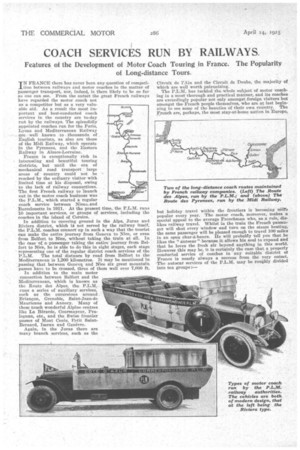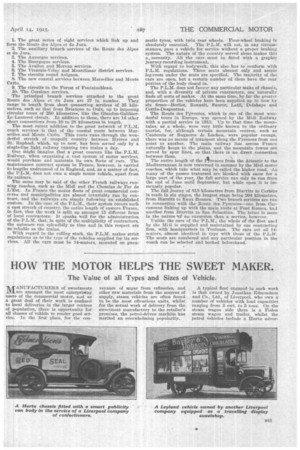COACH SERVICES RUN BY RAILWAYS.
Page 24

Page 25

If you've noticed an error in this article please click here to report it so we can fix it.
Features of the Development of Motor Coach Touring in France. The Popularity of Long-distance Tours.
IN FRANCE there has never been any question of competition between railways and motor coaches in the matter of passenger transport, nor, indeed, is there likely to be so far as one can see. From the outset the great French railways have regarded the motor coach not as a competitor but as a very valuable aid. As a result the most important and best-conducted coach services in the country are to-day run by the railways. The splendidly appointed coaches run for the Paris, Lyons and Mediterranean Railway arewell known to thousands. of English tourists, as also are those of the Midi Railway, which operate in the Pyrenees, and the Eastern Railway in Alsace-Lorraine.
France is exceptionally rich in interesting and beautiful touring districts, but until the era of mechanical road transport large areas of country could not be reached by the ordinary visitor with limited time at his disposal, owing to the lack of railway connections. The first French railway to launch out in the motor coach business was the P.L.M., which started a regular coach service between Nice and Bareelonette in 1911. At the present time, the P.L.M. runs 10 important services, or groups of services, including the coaches in the island of Corsica.
In addition to covering ground in the Alps, Juras and Riviera district, which 16 not served by the railway itself, the P.L.M. coaches connect up in such a way that the tourist can make the entire journey from Geneva to Nice, or even from BeHort to Nice, without taking the train at all. In the case -of a pa.esenger taking the entire journey from Belfort to Nice, he is able to do this in eight stages, each stage representing one of the regular district coach services of the P.L.M. The total distance by road from Belfort to the Mediterranean is 1,200 kilometres. It may he mentioned in passing that between Geneva and Nice six great mountain passes have to be crossed. three of them well over 7,000 ft.
In addition to the main motor connection between BeHort and the Mediterranean, which is known as the Route des Alpes, the P.L.M. runs a series of auxiliary services, such as the excursions around Briangon, Grenoble, Saint-Jean-de Maurienne and Annecy. Many of these touch wonderful Alpine centres like La B6rarde, Courmayeur, Prelognan, etc., and the Swiss frontier passes of Mont Cenis, Petit SaintBernard, Iseran and Genevre.
Again, in the Sures there are many branch services, such as the Circuit de l'Ain and the Circuit de Doubs, the majority of which are well worth patronizing. The P.L.M. has tackled the whole subject of motor coaching in a most thorough and practical manner, and its coaches are exceedingly popular not only amongst foreign visitors but amongst the French people themselves, who are at last beginning to see some of the beauties of their own country. The French are, perhaps, the most stay-at-home nation in Europe,
but holiday travel within the frontiers is becoming miira popular every year. The motor coach, moreover, makes a special appeal to the average Frenchman who, as a rule, dislikes railway travel. Whilst in the train the French passenger will shut every window and turn on the steam heating, the same passenger will be pleased enough to travel 100 miles in an open char-a-bancs. He will probably tell you that he likes the " autocar "because it. allows his soul to expand and that he loves the fresh air beyond anything in this world. However this may be, it is certainly the case that a properly conducted service of coaches in any suitable district of France is nearly always a success from the very outset. The autocar services of the P.L.M. may be roughly divided into ten groups:—
1. The great series of eight services which link up and farm the Route des Alms et du Jura.
2. The auxiliary branch services of the Route des Alpes et du Jura.
3. The Auvergne services.
4. The Bourgogne services.
5. The Avallon and Morvan services.
8. The Vivarais-Velay and Montelimar district services.
7. The circuits round Avignon.
8. The new coastal services between Marseilles and Monte Carlo.
9. The circuits in the Forest of Fontainebleau.
10. The Corsican services.
The principal branch services attached to the great Route des Alpes et du Jura are 27 in number. They range in length from short connecting services of 35 kilometres, such as that from Briancon to Oulx, up to imposing circular tours of 250 kilometres, like the Glandon-GalibierLe Lauteret circuit. In addition to these, there are 14 other short connections from 10 to 28 kilometres in length.
The most recent addition to the great network of P.L.M. coach services is that of the coastal route between Marseilles and Monte Carlo. This route runs through the wonderful stretch of unspoilt country between Ilyeres and St. Raphael, which, up TO now, has been served only by a single-line light railway running two trains a day.
One Might imagine that a great concern like the P.L.M. Railway, when organizing a vast System of motor services, would purchase and maintain its own fleets of cars. The maintenance contract system in Prance, however, is carried to lengths undreamed of in England, and, as a matter of fact, the P.L.M. does not own a single motor vehicle, apart from its railcars.
The same may be said of the other French railways running coaches, such as the Midi and the Chemins de Fer de L'Est. -In France the motor fleets of great commercial concerns and municipalities are almost invariably run by contract, and the railways are simply following an established custom. In the case of the P.L.M., their system covers such a vast stretch of country, the entire length of eastern France. in fact, that the work is split up amongst 15 different firms of local contractors; It speaks well for the administration of the P.L.M. that, in spite of the multiplicity of contractors, the autocars run splendidly to time and in this respect are as reliable as the trains.
With regard to the rolling stock, the P.L.M. makes strict regulations as to the type of the vehicles supplied for its services. All the cars must be 14-seaters, mounted on pnen matic tyres, with twin rear wheels. Four-wheel braking is absolutely essential. The P.L.M. will not, in any circumstances, pass a vehicle for service without a proper braking system. The nature of the country served alone makes this a.,.necessity. All the cars must be fitted with a graphic journey-recording instrument.
With regard to bodywork, this also has to conform with P.L.M. regulations. Three seats abreast only and ample leg-room under the seats are specified.. The majority of the cars are open, but a certain number of them have the rear portion of the body dosed in.
The P.L.M. does not favour any particular make of chassis. and, with a diversity of private contractors, one 'naturally finds all sorts of makes. At the same time, by far the greater proportion of the vehicles have been supplied up to now by six firms--Berliet, Renault, Bawer, Latil, Delahaye and Cottin-Desgouttes.
The Route ties Pyrenees, which is .one of the most wonderful tours in Europe, was opened by the Midi Railway with a partial service in 1913: Up to that time the .mountains, as a whole, were very little known to the ordinary tourist, for, although certain mountain centres, such as Cauterets or Bugneres de Luehon, were popular enough, there was no means of transport along the Pyrenees from one point to another. The main railway line across France naturally keeps to the plains, and the mountain towns are served by spur lines, so that there is no direct connection between them. The entire length of the Arenees from the Atlantic to the Mediterranean is now traversed in summer by the Midi motor coaches, which take what may be called the higher road. As many of the passes traversed are blocked with snow for a large part of the year, the full service can only be run from the end of June until September, but while open it is immensely popular.
The full journy of 813 kilometres from Biarritz to Cerbere is made in six stages, the longest stage being 204 kilometres, from Biarritz to Eaux Bonnes. Two branch services iire run in connection with the Route des PyreuAes—one from Carcasonne linking up with the main route at Font Romeu, had another from Biarritz to San Sebastian. The latter is more in the nature 'of an excursion than a service, however, Unlike the cars of the P.L.M., the whole of •the fleet used by the Midi is supplied and maintained by one contracting firm, with headquarters in Toulouse. The cars are all 14• seaters, almost identical in type with those of the P.L.M. The seats are numbered and any -particular position in the coach can be selected and booked beforehand.






























